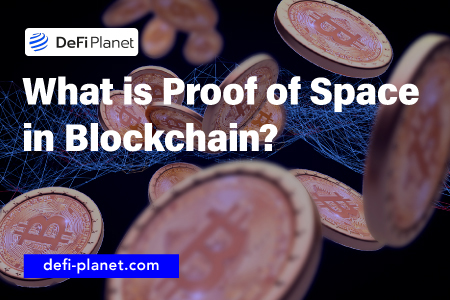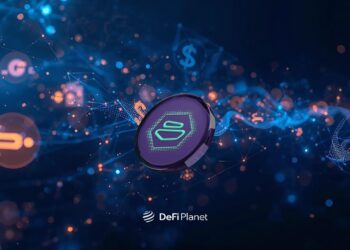Last updated on June 21st, 2023 at 04:40 pm
The high amount of energy consumed by Proof of Work (PoW) systems led to many in the cryptocurrency space looking for more efficient and greener alternatives. While Proof of Stake (PoS) systems emerged as a viable alternative to PoW, many believed that the system advocated cryptocurrency hoarding and hence was not a viable alternative. This is where Proof of Space emerged as a solution to the problems of the existing system and offered the main benefit of being more efficient in comparison to Proof of Work (PoW) and Proof of Stake (PoS) systems.
This article will talk about the Proof of Space system in blockchain, its pros and cons, and how it’s currently used by cryptocurrency projects such as Chia.
Let’s dive in!
What Is Proof Of Space In Blockchain?
Proof of Space (PoS) is a type of consensus mechanism introduced by Dziembowski and Ateniese in 2013 in their paper titled ‘Proofs of Space‘, and is currently being used by cryptocurrency projects such as Chia. It is a consensus algorithm devised as a more efficient alternative to Proof of Work and Proof of Stake systems.
In Proof of Space, spare space on a device’s hardware is used to solve a challenge provided by the service providers, i.e., the cryptocurrency hashing problem. For example, a validator in Proof of Space shows their interest in validating a transaction by allocating some memory or disk space to solve the hashing problem.
In part, Proof of Space is also motivated by the observation that users tend to always have a large amount of disk space available that is not being used. In such a case, if they use it for Proof of Space, it would mean the service is being provided essentially for free. This is in contrast to Proof of Work or Proof of Stake, where users have to either contribute computational power or stake their cryptocurrency.
On the surface level, Proof of Space is very similar to Proof of Work. The key difference is that instead of computational power, as in the case of PoW, Proof of Space uses storage. It is seen as a fairer and greener alternative by blockchain enthusiasts as one can use storage for other purposes and because of the low amount of energy consumed by storage compared to computational power. However, many often criticize Proof of Space as it results in an increasing demand for storage. Thus, the system’s bottleneck lies in the amount of required memory instead of the number of events.
For Proof of Space to be used as a consensus mechanism by any blockchain, it needs to be tied to Proof of Time (PoT). This is because PoT helps increase the blockchain’s overall security and ensures that block times are spaced equally and have consistency between them in relation to time.
What Is Proof Of Space And Time?
Proof of Space and Time (PoSt) refers to the method in which a storage miner proves that they are continuously storing blockchain data. It is a mechanism that is used by cryptocurrency projects such as Chia and Filecoin. PoSt was introduced by Tal Moran and Ilan Orlov who called it “’Rational’ Proofs of Space-Time because the true cost of storage is proportional to the product of storage capacity and the time that it is used.”
In Proof of Space-Time (PoSt) systems, participants in the network have more financial incentives to participate fairly in the network as opposed to harming it. Moreover, in PoSt systems, participants are randomly selected and are needed to prove or show that they have been physically storing data over a specified period of time.
How Chia Uses Proof of Space and Proof of Time
Implementing the concept of proving that participants are keeping space free on their hard disk drive, Chia used the Proof of Space-Time (PoSt) to run its blockchain network.
In the Chia blockchain, users called “farmers” are required to “seed” the free space on their storage devices. This is done by installing software that stores a set of cryptographic numbers on the hard disk into “plots”.
When the blockchain broadcasts a challenge for a new block, the users or the “farmers” scan their “plots” to check whether they have the hash that is needed for the challenge. The probability of a farmer winning a block depends on the percentage of the total space they have compared to the entire network of users.
Proof of time is implemented in the Chia blockchain by a Verifiable Delay Function and requires a very small period of time to pass between blocks. This quick implementation is facilitated by the Verifiable Delay Function that takes a small amount of time to compute but in general, is very fast to verify.
The primary idea of a Verifiable Delay Function (VDF) is that they need sequential computation, which enables them to minimize electricity consumption and wastage. This is because VDF uses sequential computation, and thus, having many parallel machines which need electricity does not offer any benefit.
In reality, only a few VDF servers known as “Timelords” are working actively in a Proof of Space-Time (PoSt) consensus algorithm as only one fast and fair VDF server is required on the network to complete a block to move the chain forward. Furthermore, since the quickest server always finishes first, there is no requirement for too many servers to participate in the network.
Believers of the Chia project strongly recommend using the Chia blockchain as, according to them, Chia has a significantly more decentralized blockchain. This belief stems from the fact that Chia uses the Proof of Space-Time (PoSt) consensus algorithm, which offers more security and, at the same time, removes the energy demands as a Proof of Work (PoW) system would need. In addition, the believers advocate that by adopting more modern cryptographic tools that enable richer smart transaction capabilities, Chia is taking a new and superior approach to supporting a blockchain.
Pros and Cons Of Proof of Space
Here are the pros and cons of using Proof of Space in blockchain:
| Pros | Cons |
| Becoming part of a Proof of Space blockchain does not require high capital investment in securing hardware devices. Users can participate even with a regular hard drive. | Only a handful of projects and developers have adopted the Proof of Space system. |
| The equipment, i.e. the hard drives does not need to be regularly updated. | Mining activities can be affected if there is a problem with the malware. |
| Validators can re-use the hard drives for any other purpose by easily wiping off the mining data. | Wider adoption of Proof of Space could promote the production of higher capacity hard drives for increased storage. This would result in an increased demand for energy and thus, reducing the benefits of using PoS in the first place. |
In Conclusion
- In theory, Proof of Space offers many benefits compared to Proof of Work and Proof of Stake consensus algorithms. Still, in reality, the concept lacks widespread adoption as only a handful of cryptocurrency projects have adopted the system. Thus, until the system is implemented at scale, it would be hard to tell if it has genuine potential to one day replace PoW and PoS systems currently used by most blockchains.
Comment below and let us know more!
If you would like to read more articles like this, follow DeFi Planet on Twitter and LinkedIn.





















